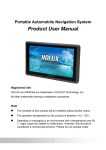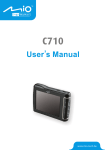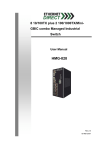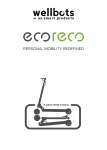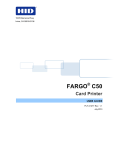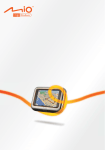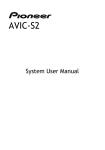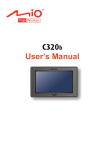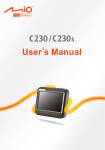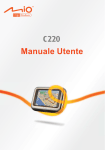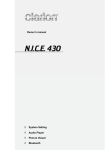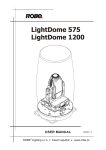Download User`s Manual (English for USA)
Transcript
Revision: R00 (USA) Trademarks All brand and product names are trademarks or registered trademarks of their respective companies. Note Information in this manual is subject to change without notice. Table of Contents Warnings and Notices............................................................................iii 1 Getting Started..................................................................................1 1.1 1.2 1.3 1.4 2 MP3 ..................................................................................................11 2.1 2.2 2.3 2.4 2.5 2.6 3 Understanding Hardware Components................................................ 1 Front and Side Components ................................................................ 1 Back Components................................................................................ 2 Top Components.................................................................................. 3 Bottom Components ............................................................................ 3 Performing the Initial Start Up .............................................................. 4 Using Your Device in a Vehicle............................................................ 6 Using the Device Holder ...................................................................... 6 Connecting the Car Charger ................................................................ 6 Operating Basics.................................................................................. 7 Turning On and Off .............................................................................. 7 Operating the Device ........................................................................... 7 Home Screen ....................................................................................... 8 Inserting a SD/MMC Card .................................................................... 9 Starting and Exiting MP3 Player ........................................................ 11 Preparing the MP3 Files for You Device............................................ 12 Playing MP3 Files .............................................................................. 12 MP3 Playback Controls...................................................................... 13 Using the Play Lists............................................................................ 14 Creating a Play List ............................................................................ 14 Opening a Play List ............................................................................ 15 Equalizer ............................................................................................ 16 Settings............................................................................................19 3.1 3.2 Starting and Exiting Settings .............................................................. 19 Backlight............................................................................................. 20 i 3.3 3.4 3.5 3.6 3.7 4 Mio Transfer ....................................................................................27 4.1 4.2 4.3 5 5.3 Resetting Your System ...................................................................... 33 Troubleshooting ................................................................................. 34 Power Problems ................................................................................. 34 Screen Problems................................................................................ 34 Connection Problems......................................................................... 35 GPS Problems.................................................................................... 35 Maintaining Your Device .................................................................... 36 Regulatory Information ..................................................................37 6.1 6.2 ii Installing Mio Transfer........................................................................ 27 Starting and Exiting Mio Transfer....................................................... 29 Copying MP3 Files to Your Device .................................................... 30 Managing Your MP3 Files.................................................................. 32 Troubleshooting and Maintenance ...............................................33 5.1 5.2 6 Volume ............................................................................................... 21 Screen ................................................................................................ 22 Power ................................................................................................. 23 Date&Time ......................................................................................... 24 Change Language.............................................................................. 25 Regulations Statements ..................................................................... 37 Class B Regulations........................................................................... 37 European Notice ................................................................................ 38 Safety Precautions ............................................................................. 39 About Charging .................................................................................. 39 About the AC Adapter ........................................................................ 39 About the Battery ............................................................................... 40 Warnings and Notices z For your safety, do not operate the controls of the product while driving. z Use this product with caution. The product is a navigation aid. It does not provide exact measurements of direction, distance, location or topography. z The calculated route is for reference only. Always follow the posted traffic signs, speed limits and road restrictions. z When you leave your car, do not leave your device on the dashboard in direct sunlight. This can cause the battery to overheat and malfunction. z The Global Positioning System (GPS) is operated by the United States government, which is solely responsible for its performance. Any change to the GPS system can affect the accuracy of all GPS equipment world-wide. z GPS satellite signals cannot typically pass through solid materials (except glass). GPS location information is not typically available inside buildings, tunnels, or underground parking lots. z A minimum of 4 GPS satellite signals is needed to calculate your GPS position. Signal reception can be affected by weather events or overhead obstacles (e.g. dense foliage and tall buildings). z Other wireless devices in the vehicle may interfere with the reception of satellite signals and cause the reception to be unstable. iii z A device holder is needed when using the device in a car. Be sure to place the device in an appropriate place, so as not to obstruct the driver’s view, or deployment of airbags. Do not mount where the driver’s field of vision is blocked. Do not mount in front of airbag panels. iv Do not place on the dashboard unsecured. Do not mount in front of an airbag field of deployment. 1 Getting Started 1.1 Understanding Hardware Components NOTE: Depending upon the specific model purchased, the color of your device may not exactly match the device shown in this manual. Front and Side Components Ref n Component Charge Indicator o Touch Screen p Power Button Description Glows in bright amber to indicate that the battery is charging, and turns green when the battery is fully charged. Displays the output of your device. Tap the screen with your fingertip to select menu commands or enter information. Turns on and off the device. 1 q Menu Button Displays the Home screen. r Volume Control Adjusts the volume level of your device. Back Components Ref Component Description n External Antenna Connector This connector (under rubber dust cover) allows use of an optional external GPS antenna with magnetic mount, which may be positioned on top of the car for better GPS signal reception in areas with poor reception. o Speaker Sends out music, sounds and voice. p Hand String Hole Hand string attaches to this hole. 2 Top Components Ref Component n GPS Antenna o SD/MMC Slot Description Receives signals from the GPS satellites overhead. Make sure that it has a clear view of the sky. Accepts a SD (Secure Digital) or MMC (MultiMediaCard) card for accessing data such as MP3 music. Bottom Components Ref Component n Reset Button Description Restarts your device (soft reset). o Headphone Connects to stereo headphones. Connector p Mini-USB Connector Connects to the AC adapter or USB cable. q ON/OFF Switch The main power/battery cutoff switch. 3 1.2 Performing the Initial Start Up 1. Using a pointed pen, slide the ON/OFF switch to the ON position. CAUTION: Always leave the ON/OFF switch in the ON position for normal operation. 2. Your device turns on. 3. The “Change Language” screen appears. Tap the left/right arrow button to button. select the desired language. Then, tap the 4. The “Date&Time” screen appears. Tap the appropriate arrow button to select the time zone, date, and time. Then, tap the button. 4 5. The Home screen appears. You can now use your device. 5 1.3 Using Your Device in a Vehicle A device holder and car charger are supplied with your device. Using the Device Holder Use the device holder to mount your device in a vehicle. Make sure that the GPS antenna has a clear view of the sky. (See the document supplied with the device holder for the installation instruction.) NOTE: z Depending upon the specific model purchased, the device holder supplied with your device may not look exactly the same as the picture shown. z If the car’s windshield is tinted with a reflective coating, an external antenna (optional) may be needed to route the antenna to the top of the car through a window. Connecting the Car Charger The car charger supplies power to your device when you are using the device in a car. CAUTION: To protect your device against sudden surges in current, connect the car charger only after the car engine has started. 1. Connect one end of the car charger to the power connector of your device. 2. Connect the other end to the 12-volt cigarette lighter or power port to power and charge your device. The indicator light on the car charger lights in green to indicate that power is being supplied to your device. NOTE: Your device can also be charged when it is connected to a desktop computer via the USB cable. 6 To Cigarette Lighter 1.4 Operating Basics Turning On and Off Use the power button ( device. ) to turn on and off your When you press the power button to turn off the unit, your device enters a suspend state and the system stops operating. When you turn on the system, it resumes. Operating the Device To operate your device, touch the screen with your fingertip. You can perform the following actions: z Tap Touch the screen once with your fingertip to open items or select onscreen buttons or options. z Drag Hold your fingertip on the screen and drag up/down/left/right or across the screen. z Tap and hold Tap and hold your fingertip until an action is complete, or a result or menu is shown. 7 Home Screen The first time you initialize your device, the Home screen appears. The Home screen is your starting place for various tasks. Tap a button to start a task or open another menu. You can access the Home screen at any time by pressing the Menu ( on the side of your device. Button Name Description Mio Map Starts the navigation software. MP3 Settings Plays MP3 music. Customizes the system settings. 8 ) button For Detailed Information See the manual supplied with the software. Chapter 2 Chapter 3 Inserting a SD/MMC Card Your device has a SD/MMC slot where you can insert an optional Secure Digital or MultiMediaCard storage card. To use a card, insert it into the slot, with the connector pointing to the slot and its label facing the front of the device. To remove a card, first make sure that no application is accessing the card, then slightly push the top edge of the card to release it and pull it out of the slot. NOTE: z Make sure that no foreign objects enter the slot. z Keep a SD or MMC card in a well-protected box to avoid dust and humidity when you are not using it. 9 2 MP3 2.1 Starting and Exiting MP3 Player MP3 turns your device into an MP3 player. It features: z Playback of MP3 files z Basic playback controls such as play, pause, stop, next and previous z Playback includes single selection playback, repeat, single repeat, sampling playback, normal sequence and random sequence. z 11 preset equalizer audio profiles z Play list support Tap the MP3 button on the Home screen to start the program. The control panel appears on the screen where you can easily control the player by tapping the control buttons. Æ To exit the program, tap . 11 2.2 Preparing the MP3 Files for You Device Before using the program, have the MP3 files ready on either your device’s flash memory or on a storage card. A tool called Mio Transfer is supplied for you to easily copy the files from your computer to the correct location. (See section 4.3 for information.) 2.3 Playing MP3 Files 1. If your files are in a storage card, insert the card into your device. 2. Tap the MP3 button on the Home screen to start the program. 3. The program will search for the MP3 files in your device and in the storage card. When MP3 files are detected, they will be added to the play list. NOTE: You can create your own play lists for future playback. (See section 2.5 for details.) 4. To start the playback, tap buttons as described later. . To control the playback, use the control You can enjoy the music while using the other functions of your device. To play the music in the background, tap 12 . 2.4 MP3 Playback Controls Control Button Name Description Play/Pause Play or pause the playback. Stop Stop the playback. Previous/ Next Play the previous or next file. Volume Increase or decrease the volume. The indicator on the panel shows the current volume level. Minimize the MP3 control panel and play the music in the background. To open the MP3 control panel, tap the MP3 button on the Home screen. Close the program and return to the Home screen. / / / Minimize Exit Play List Equalizer Playback Mode Open play list. (See Section 2.5 for more information.) Open or close the equalizer panel. (See Section 2.6 for more information.) Cycle through the following modes: Repeated playback of all files in sequence Repeated playback of all files in random order Sampling playback in sequence Sampling playback in random order Single playback of the current file Repeated playback of the current file Help Introduce the function and operation of each button. Tap a button to see a description line at the bottom of the screen. 13 2.5 Using the Play Lists By default, the program automatically loads all MP3 files in the play list. You can also create your own play lists for future use. Creating a Play List 1. After starting MP3, tap on the control panel to open the play list screen. The screen shows the current play list. Add song Back Remove current song from the list. Remove all songs from the list. 2. To add a song to the play list, tap Save the play list. Open the list of play lists. . A screen appears displaying all the MP3 files. Tap the song you wish to add and then tap 14 . Select all songs. Back Add the selected song(s) to the play list and return to the previous screen. Deselect the selected song(s). Add the selected song(s) to the play list. 3. Repeat the same procedure for the other songs to be added. 4. To save the play list, tap . 5. To return to the control panel, tap . Opening a Play List To open one of the play lists that you have created: 1. After starting MP3, tap 2. Tap on the control panel. to display all the play lists you have created. 3. Tap the play list you want to open and tap . 15 Back Open the selected play list. Delete the selected play list. 4. To return to the control panel, tap Delete all the play lists except the selected one. . 2.6 Equalizer The program provides 11 preset audio profiles. Tap panel. to open the equalizer Tap or to cycle through the available options: Default, Rock, Pop, Jazz, Classic, Dance, Heavy, Disco, Soft, 3D, and Hall. 16 Tap to save your selection and return to the control panel. Tap your selection and return to the control panel. To select the Default profile, tap to cancel . 17 3 Settings 3.1 Starting and Exiting Settings You can customize the system settings such as backlight brightness, volume, and language. Once you change the settings, the new settings will remain until you change them again. Tap the Settings button on the Home screen. The Settings menu appears as shown below. Æ To exit Settings, tap . The following sections describe the various buttons and their functions. 19 3.2 Backlight 1. Tap the Settings button on the Home screen. 2. Tap the Backlight button. 3. Move the knob along the track bar to adjust the brightness of the backlight. To darken the backlight, move the knob to the left. To lighten the backlight, move the knob to the right. 4. Tap 20 to save the changes. 3.3 Volume 1. Tap the Settings button on the Home screen. 2. Tap the Volume button. 3. Move the knob along the track bar to adjust the volume. To decrease the volume, move the knob to the left. To increase the volume, move the knob to the right. 4. Tap save the changes. 21 3.4 Screen You can calibrate the touch screen if it is not responding accurately to your taps. 1. Tap the Settings button on the Home screen. 2. Tap the Screen button. 3. Tap to start the calibration. 4. Tap and hold the centre of the target. 22 5. When the target moves to another position, tap and hold the centre of the new target. Repeat each time to complete the calibration process. 6. When completed, tap . 3.5 Power To check the remaining power level of your battery and/or set up the power saving feature: 1. Tap the Settings button on the Home screen. 2. Tap the Power button. 3. The screen shows the remaining power of your battery. You can set a timer to automatically turn off your device when it is idle for a set period of time. The options include Never, 30 minutes, 20 minutes, and 10 minutes. 23 4. Tap to save the changes. 3.6 Date&Time 1. Tap the Settings button on the Home screen. 2. Tap the Date&Time button. 3. To change the time zone, tap the left/right arrow in the “Time Zone” item. 24 4. To change the date, tap the down arrow in the “Date” item. A calendar pops up. Tap the left arrow on the calendar to go to the earlier month and year or the right arrow to the later month and year. Alternatively, you can tap the month or year on top of the calendar to directly change the month or year. When the calendar shows the current month, tap the date on the calendar. 5. To set the time, first tap the hour, minute, or second in the “Time” item and then tap the up arrow to increase or down arrow to decrease the value. 6. Tap to save the changes. 3.7 Change Language NOTE: To change the language of the Mio Map navigation software, use Mio Map settings. (See the document supplied with the navigation software.) 1. Tap the Settings button on the Home screen. 2. Tap the Change Language button. 25 3. Tap the left/right arrow button to select the desired language. 4. Tap 5. Tap the 26 to save the changes. button for the new setting to take effect. 4 Mio Transfer 4.1 Installing Mio Transfer Mio Transfer allows you to easily transfer data such as MP3 files between your device and a computer. To install Mio Transfer to your computer: 1. Turn on your computer and insert the CD/DVD supplied with your device into the CD/DVD-ROM drive of your computer. 2. When the Language Selecting screen appears, click the language that you wish to install from. 27 3. Click Install Mio Transfer. 4. Click Next. Follow the onscreen instructions to complete the installation. NOTE: If Mio Transfer has already been installed on your computer, clicking Installl Mio Transfer will remove the application from your system. 28 4.2 Starting and Exiting Mio Transfer Click Mio Transfer icon on the Windows Desktop to start the program. The Mio Transfer screen appears. The menu bar of Mio Transfer contains the following tabs: z MP3 Allows you to transfer the MP3 files between your device and your computer. (See section 4.3 for details.) z Online Provides link to the Mio website. z About Provides program information. To exit Mio Transfer, click Exit at the bottom right corner of the screen. 29 4.3 Copying MP3 Files to Your Device Before playing MP3 music, you need to have the MP3 files ready on your device. Use Mio Transfer to copy the files form your computer to the correct location on your device. 1. If you want to copy MP3 files to a storage card, insert the card to your device. 2. Turn on your computer and your device. 3. Connect the mini-USB end of the USB cable to the bottom of your device and the other end to a USB port on your computer. 4. Start Mio Transfer by clicking Mio Transfer icon on the Windows Desktop. The Mio Transfer screen appears. 5. Click MP3 on the top menu bar. The left column shows the drives of your computer and the right column shows the files in the appropriate folder of the target device (either ). 30 or Target Device 6. Select your target device by clicking one of the icons: z - the flash memory of your device z - a storage card inserted into your device. 7. Select the folder where your MP3 or picture files are stored from the left button. The status bar column. Select the file you want to copy and tap will indicate the progress of file transfer and the selected file will be copied to the target device. NOTE: You can also copy the files from your device to your computer. First select the file you want to copy from the right column and and select a folder on the left column to place these files. Then click to start the file transfer. 31 Managing Your MP3 Files Various buttons are available for you to manage the files: z Rename Changes the name of the selected file. z Delete Removes the selected file. CAUTION: Be discrete when you delete files. Deleting files of which the function is unknown can cause programs or features to malfunction. z Cancel Aborts the ongoing action of file transfer. z New Folder Creates a new folder in the selected drive or folder. 32 5 Troubleshooting and Troubleshooting and Maintenance Maintenance 5.1 Resetting Your System Occasionally, you may need to reset your device. For example, you should reset your system when it stops responding; or appears to be “frozen” or “locked up.” Insert a small rod, such as a straightened paperclip, into the reset button of your device. This is called a “soft reset.” The Home screen should appear after a soft reset. If your device still does not respond after a soft reset, you can use the following steps to perform a “hard reset.” 1. Disconnect all cables, including the AC adapter, from your device. 2. Use a pointed pen to slide the ON/OFF switch to the OFF position. 3. Wait for 1 minute and then slide the switch back to the ON position. 33 Wait for 1 minute. 5.2 Troubleshooting NOTE: If you encounter a problem you cannot solve, contact an authorized service center for assistance. Power Problems Power does not turn on when using battery power z The remaining battery power may be too low to run your device. Connect the AC adapter to your device and to AC power. Then, turn on your device. Screen Problems Screen is off If the screen does not respond even after you press the power button, try the following in order until the problem is solved: z Connect the AC adapter to your device and to external AC power. z Reset your system. 34 Screen responds slowly z Make sure that your device is not running out of battery power. If the problem still exists, reset your system. Screen freezes z Reset your system. Screen is hard to read z Make sure that the backlight of the display is on. z Move to a location with more light. Inaccurate response to taps z Recalibrate the touch screen. (See section 3.4 for instructions.) Connection Problems Cable Connection Problems z Make sure that your device and your computer are both turned on before trying to establish a connection. z Make sure that the cable is securely plugged into the USB port on your computer and on the device. Connect the USB cable directly to your computer—do not run the cable through a USB hub. z Reset your device before connecting the cable. Always disconnect your device before you restart your computer. GPS Problems When there are no valid signals available, consider the following: z Make sure that the GPS antenna has a clear view of the sky. z Note that the GPS reception can be affected by: 9 Bad weather 9 Dense overhead obstacles (e.g. trees and tall buildings) 9 Other wireless device in the car 9 Reflective car window tint 35 5.3 Maintaining Your Device Taking good care of your device will ensure trouble-free operation and reduce the risk of damage to your device. z Keep your device away from excessive moisture and extreme temperatures. z Avoid exposing your device to direct sunlight or strong ultraviolet light for extended periods of time. z Do not place anything on top of your device or drop objects on your device. z Do not drop your device or subject it to severe shock. z Do not subject your device to sudden and severe temperature changes. This could cause moisture condensation inside the unit, which could damage your device. In the event of moisture condensation, allow the device to dry out completely before use. z Do not sit on your device. Avoid carrying your device in your back pocket. z The screen surface can be easily scratched. Sharp objects may scratch the screen. You may use non-adhesive generic screen protectors designed specifically for use on portable devices with LCD panels to help protect the screen from minor scratches. z Never clean your device with it powered on. Use a soft, lint-free cloth moistened with water to wipe the screen and the exterior of your device. z Do not use paper towels to clean the screen. z Never attempt to disassemble, repair or make any modifications to your device. Disassembly, modification or any attempt at repair could cause damage to your device and even bodily injury or property damage and will void any warranty. z Do not store or carry flammable liquids, gases or explosive materials in the same compartment as your device, its parts or accessories. 36 6 Regulatory Information NOTE: Marking labels located on the exterior of your device indicate the regulations that your model complies with. Please check the marking labels on your device and refer to the corresponding statements in this chapter. Some notices apply to specific models only. 6.1 Regulations Statements Class B Regulations USA Federal Communications Commission Radio Frequency Interference Statement NOTE: This equipment has been tested and found to comply with the limits for a Class B digital device pursuant to Part 15 of the FCC Rules. These limits are designed to provide reasonable protection against harmful interference in a residential installation. This equipment generates, uses, and can radiate radio frequency energy and, if not installed and used in accordance with the instructions, may cause harmful interference to radio communications. However, there is no guarantee that interference will not occur in a particular installation. If this equipment does cause harmful interference to radio or television reception, which can be determined by turning the equipment off and on, the user is encouraged to try to correct the interference by one or more of the following measures: z Reorient or relocate the receiving antenna. 37 z Increase the separation between the equipment and receiver. z Connect the equipment into an outlet on a circuit different from that to which the receiver is connected. z Consult the dealer or an experienced radio/TV technician for help. Any changes or modifications not expressly approved by the manufacturer could void the user’s authority to operate the equipment. Please note: The use of a non-shielded interface cable with this equipment is prohibited. Canada Canadian Department Of Communications Radio Interference Regulations Class B Compliance Notice This Class B digital apparatus meets all requirements of the Canada Interference-Causing equipment regulations. Cet appareil numérique de Classe B respecte toutes les exigences du Règlement Canadien sur le matériel brouileur. European Notice Products with the CE marking comply with Radio & Telecommunication Terminal Equipment Directive (R&TTE) (1999/5/EEC), the Electromagnetic Compatibility Directive (89/336/EEC) and the Low Voltage Directive (73/23/EEC) – as amended by Directive 93/68/ECC - issued by the Commission of the European Community. Compliance with these directives implies conformity to the following European Standards: EN301489-1: Electronic compatibility and Radio spectrum Matters (ERM), ElectroMagnetic Compatibility (EMC) standard for radio equipment and services; Part 1: Common technical requirements EN301489-3: Electronic compatibility and Radio spectrum Matters (ERM), ElectroMagnetic Compatibility (EMC) standard for radio equipment and services; Part 3: Specific conditions for Short-Range Devices (SRD) operating on frequencies between 9 kHz and 40 GHz EN55022: Radio disturbance characteristics EN55024: Immunity characteristics 38 EN6100-3-2: Limits for harmonic current emissions EN6100-3-3: Limitation of voltage fluctuation and flicker in low-voltage supply system EN60950 / IEC 60950: Product Safety The manufacturer cannot be held responsible for modifications made by the User and the consequences thereof, which may alter the conformity of the product with the CE Marking. 6.2 Safety Precautions About Charging z Use only the AC adapter supplied with your device. Use of another type of AC adapter will result in malfunction and/or danger. z This product is intended to be supplied by a LISTED Power Unit marked with “LPS”, “Limited Power Source” and output rated + 5 V dc / 1.0 A”. z Use a specified battery in the equipment. About the AC Adapter z Do not use the adapter in a high moisture environment. Never touch the adapter when your hands or feet are wet. z Allow adequate ventilation around the adapter when using it to operate the device or charge the battery. Do not cover the AC adapter with paper or other objects that will reduce cooling. Do not use the AC adapter while it is inside a carrying case. z Connect the adapter to a proper power source. The voltage requirements are found on the product case and/or packaging. z Do not use the adapter if the cord becomes damaged. z Do not attempt to service the unit. There are no serviceable parts inside. Replace the unit if it is damaged or exposed to excess moisture. 39 About the Battery z Use a specified charger approved by the manufacturer. CAUTION: This unit contains a non-replaceable internal Lithium Ion battery. The battery can burst or explode, releasing hazardous chemicals. To reduce the risk of fire or burns, do not disassemble, crush, puncture, or dispose of in fire or water. z 40 Important instructions (for service personnel only) 9 Caution: Risk of explosion if battery is replaced by an incorrect type. Dispose of used batteries according to the instructions. 9 Replace only with the same or equivalent type recommended by the manufacturer. 9 The battery must be recycled or disposed of properly. 9 Use the battery only in the specified equipment.















































